MGBBT0UCT - Understanding Customers: Tourism Sector Report
VerifiedAdded on 2022/01/15
|8
|2141
|347
Report
AI Summary
This report, titled 'Understanding Customers,' analyzes the micro and macro factors that influence customer behavior, using the tourism sector as a case study. The introduction defines customer understanding and its influencing factors, setting the stage for a discussion on the microenvironment, including vendors, consumers, and community influences. The report references various theories, such as how societal norms and expectations shape customer decisions and the impact of economic conditions and individual needs on purchasing behavior. The report also emphasizes the importance of customer service, consumer theory, and customer engagement. It concludes by highlighting the essentiality of customer understanding for any business's success, referencing Adam Smith's perspective on the customer's role in competitiveness.
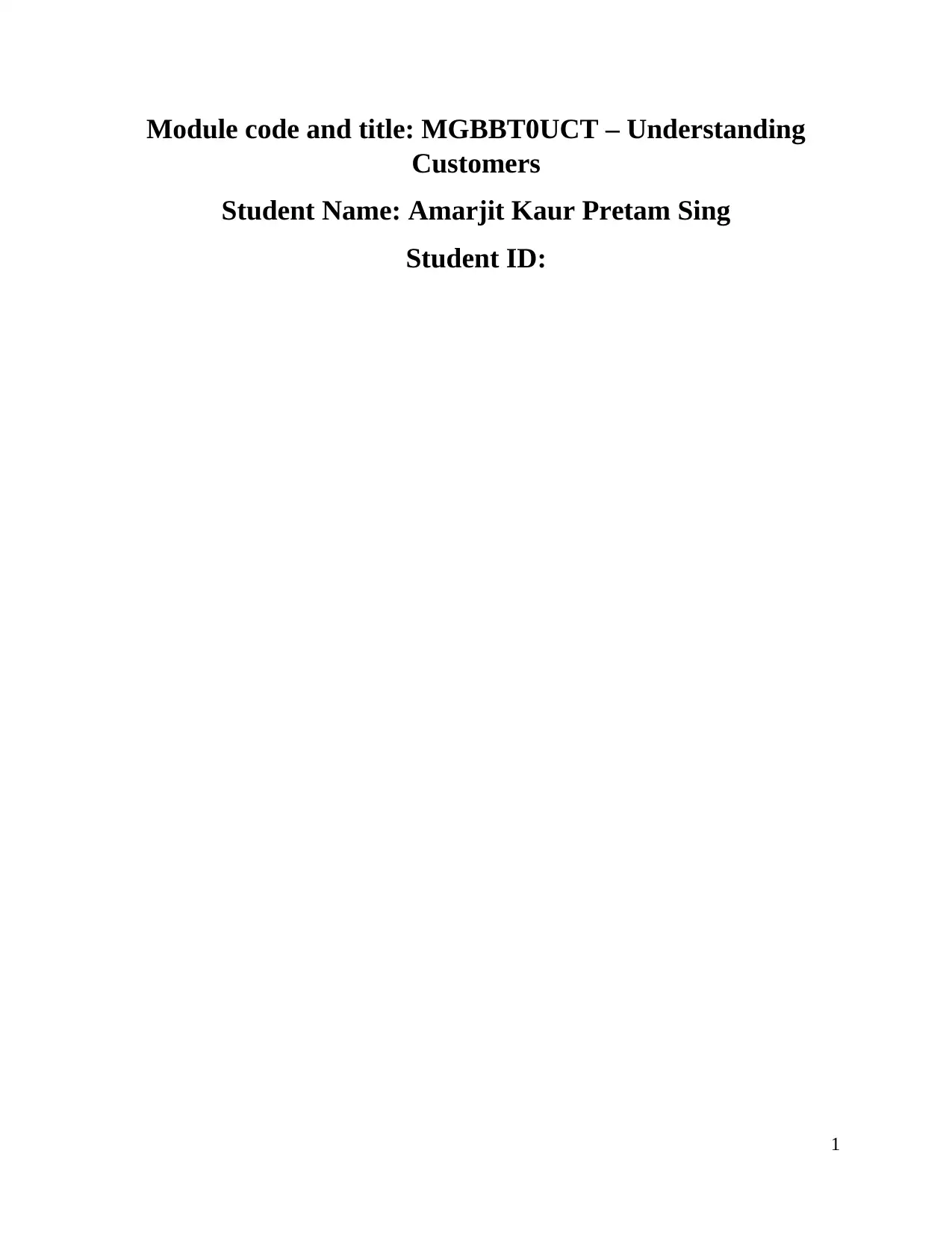
Module code and title: MGBBT0UCT – Understanding
Customers
Student Name: Amarjit Kaur Pretam Sing
Student ID:
1
Customers
Student Name: Amarjit Kaur Pretam Sing
Student ID:
1
Secure Best Marks with AI Grader
Need help grading? Try our AI Grader for instant feedback on your assignments.
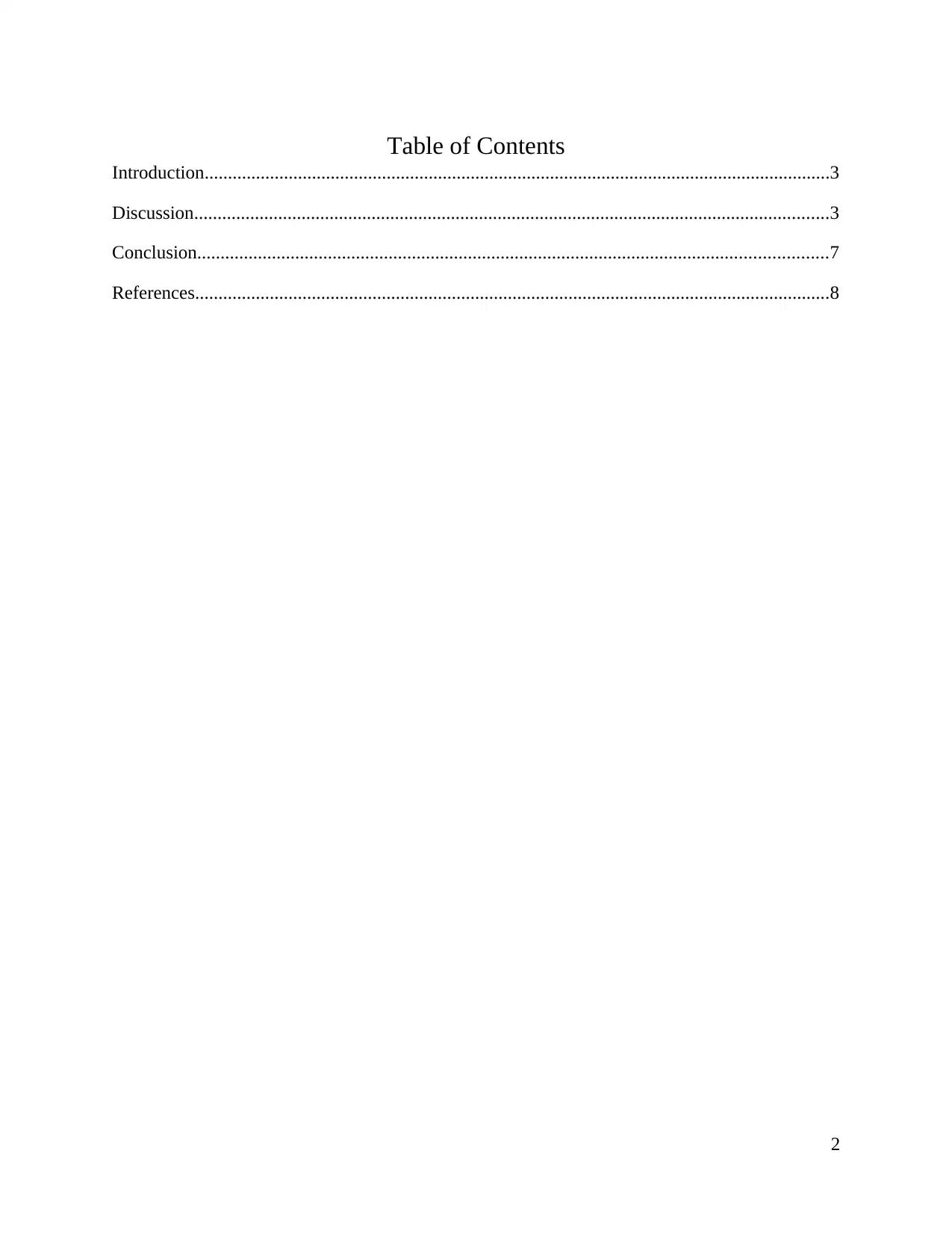
Table of Contents
Introduction......................................................................................................................................3
Discussion........................................................................................................................................3
Conclusion.......................................................................................................................................7
References........................................................................................................................................8
2
Introduction......................................................................................................................................3
Discussion........................................................................................................................................3
Conclusion.......................................................................................................................................7
References........................................................................................................................................8
2
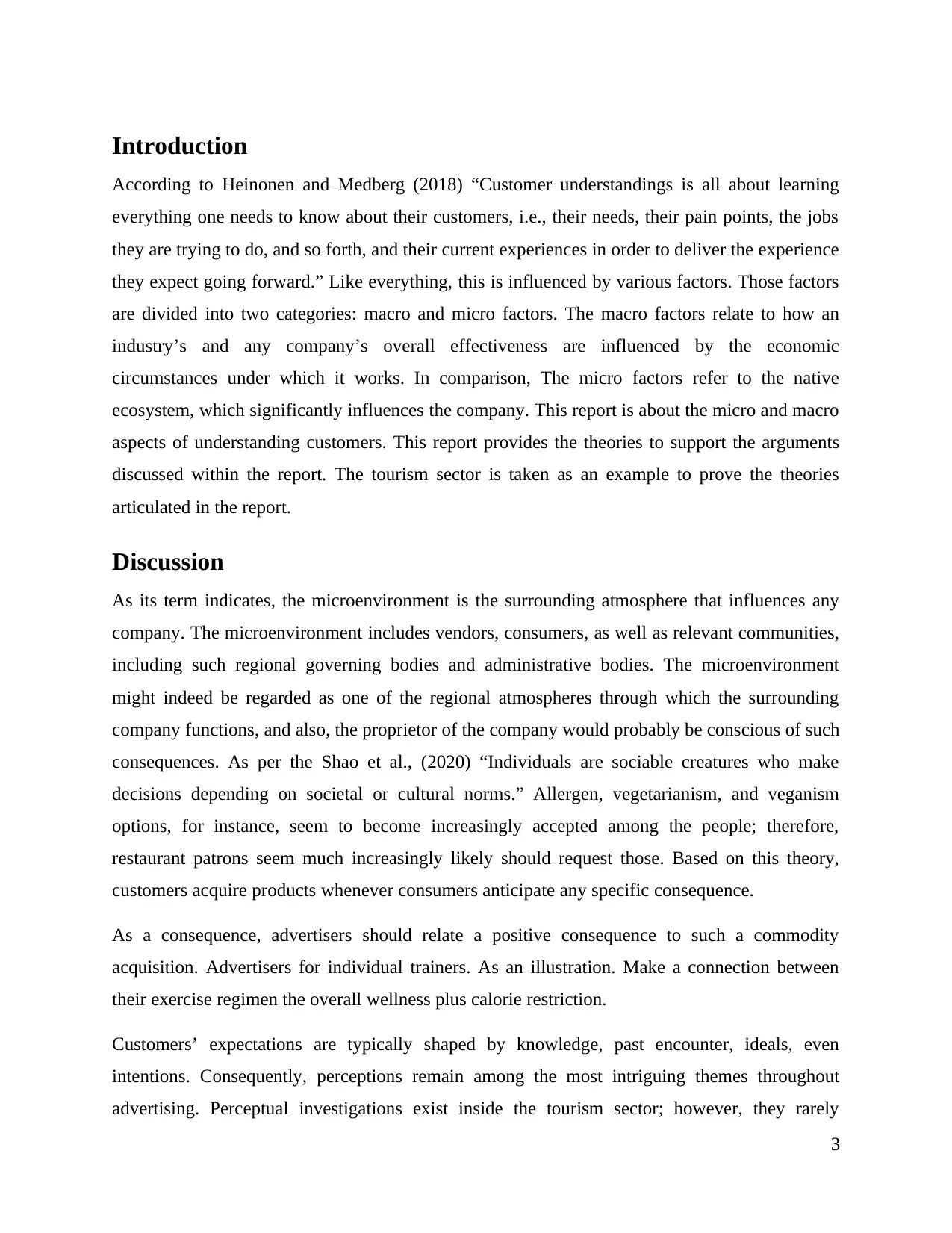
Introduction
According to Heinonen and Medberg (2018) “Customer understandings is all about learning
everything one needs to know about their customers, i.e., their needs, their pain points, the jobs
they are trying to do, and so forth, and their current experiences in order to deliver the experience
they expect going forward.” Like everything, this is influenced by various factors. Those factors
are divided into two categories: macro and micro factors. The macro factors relate to how an
industry’s and any company’s overall effectiveness are influenced by the economic
circumstances under which it works. In comparison, The micro factors refer to the native
ecosystem, which significantly influences the company. This report is about the micro and macro
aspects of understanding customers. This report provides the theories to support the arguments
discussed within the report. The tourism sector is taken as an example to prove the theories
articulated in the report.
Discussion
As its term indicates, the microenvironment is the surrounding atmosphere that influences any
company. The microenvironment includes vendors, consumers, as well as relevant communities,
including such regional governing bodies and administrative bodies. The microenvironment
might indeed be regarded as one of the regional atmospheres through which the surrounding
company functions, and also, the proprietor of the company would probably be conscious of such
consequences. As per the Shao et al., (2020) “Individuals are sociable creatures who make
decisions depending on societal or cultural norms.” Allergen, vegetarianism, and veganism
options, for instance, seem to become increasingly accepted among the people; therefore,
restaurant patrons seem much increasingly likely should request those. Based on this theory,
customers acquire products whenever consumers anticipate any specific consequence.
As a consequence, advertisers should relate a positive consequence to such a commodity
acquisition. Advertisers for individual trainers. As an illustration. Make a connection between
their exercise regimen the overall wellness plus calorie restriction.
Customers’ expectations are typically shaped by knowledge, past encounter, ideals, even
intentions. Consequently, perceptions remain among the most intriguing themes throughout
advertising. Perceptual investigations exist inside the tourism sector; however, they rarely
3
According to Heinonen and Medberg (2018) “Customer understandings is all about learning
everything one needs to know about their customers, i.e., their needs, their pain points, the jobs
they are trying to do, and so forth, and their current experiences in order to deliver the experience
they expect going forward.” Like everything, this is influenced by various factors. Those factors
are divided into two categories: macro and micro factors. The macro factors relate to how an
industry’s and any company’s overall effectiveness are influenced by the economic
circumstances under which it works. In comparison, The micro factors refer to the native
ecosystem, which significantly influences the company. This report is about the micro and macro
aspects of understanding customers. This report provides the theories to support the arguments
discussed within the report. The tourism sector is taken as an example to prove the theories
articulated in the report.
Discussion
As its term indicates, the microenvironment is the surrounding atmosphere that influences any
company. The microenvironment includes vendors, consumers, as well as relevant communities,
including such regional governing bodies and administrative bodies. The microenvironment
might indeed be regarded as one of the regional atmospheres through which the surrounding
company functions, and also, the proprietor of the company would probably be conscious of such
consequences. As per the Shao et al., (2020) “Individuals are sociable creatures who make
decisions depending on societal or cultural norms.” Allergen, vegetarianism, and veganism
options, for instance, seem to become increasingly accepted among the people; therefore,
restaurant patrons seem much increasingly likely should request those. Based on this theory,
customers acquire products whenever consumers anticipate any specific consequence.
As a consequence, advertisers should relate a positive consequence to such a commodity
acquisition. Advertisers for individual trainers. As an illustration. Make a connection between
their exercise regimen the overall wellness plus calorie restriction.
Customers’ expectations are typically shaped by knowledge, past encounter, ideals, even
intentions. Consequently, perceptions remain among the most intriguing themes throughout
advertising. Perceptual investigations exist inside the tourism sector; however, they rarely
3
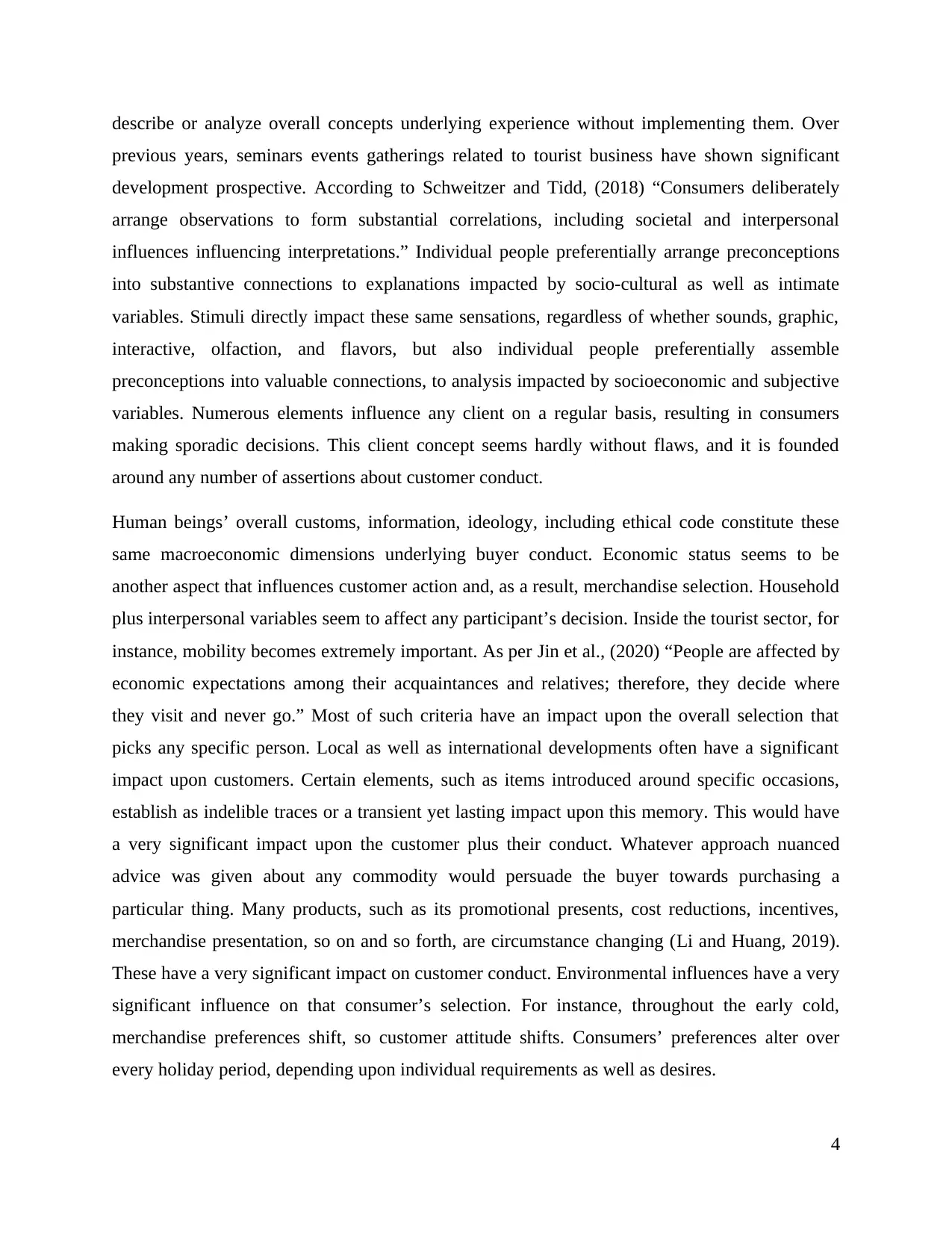
describe or analyze overall concepts underlying experience without implementing them. Over
previous years, seminars events gatherings related to tourist business have shown significant
development prospective. According to Schweitzer and Tidd, (2018) “Consumers deliberately
arrange observations to form substantial correlations, including societal and interpersonal
influences influencing interpretations.” Individual people preferentially arrange preconceptions
into substantive connections to explanations impacted by socio-cultural as well as intimate
variables. Stimuli directly impact these same sensations, regardless of whether sounds, graphic,
interactive, olfaction, and flavors, but also individual people preferentially assemble
preconceptions into valuable connections, to analysis impacted by socioeconomic and subjective
variables. Numerous elements influence any client on a regular basis, resulting in consumers
making sporadic decisions. This client concept seems hardly without flaws, and it is founded
around any number of assertions about customer conduct.
Human beings’ overall customs, information, ideology, including ethical code constitute these
same macroeconomic dimensions underlying buyer conduct. Economic status seems to be
another aspect that influences customer action and, as a result, merchandise selection. Household
plus interpersonal variables seem to affect any participant’s decision. Inside the tourist sector, for
instance, mobility becomes extremely important. As per Jin et al., (2020) “People are affected by
economic expectations among their acquaintances and relatives; therefore, they decide where
they visit and never go.” Most of such criteria have an impact upon the overall selection that
picks any specific person. Local as well as international developments often have a significant
impact upon customers. Certain elements, such as items introduced around specific occasions,
establish as indelible traces or a transient yet lasting impact upon this memory. This would have
a very significant impact upon the customer plus their conduct. Whatever approach nuanced
advice was given about any commodity would persuade the buyer towards purchasing a
particular thing. Many products, such as its promotional presents, cost reductions, incentives,
merchandise presentation, so on and so forth, are circumstance changing (Li and Huang, 2019).
These have a very significant impact on customer conduct. Environmental influences have a very
significant influence on that consumer’s selection. For instance, throughout the early cold,
merchandise preferences shift, so customer attitude shifts. Consumers’ preferences alter over
every holiday period, depending upon individual requirements as well as desires.
4
previous years, seminars events gatherings related to tourist business have shown significant
development prospective. According to Schweitzer and Tidd, (2018) “Consumers deliberately
arrange observations to form substantial correlations, including societal and interpersonal
influences influencing interpretations.” Individual people preferentially arrange preconceptions
into substantive connections to explanations impacted by socio-cultural as well as intimate
variables. Stimuli directly impact these same sensations, regardless of whether sounds, graphic,
interactive, olfaction, and flavors, but also individual people preferentially assemble
preconceptions into valuable connections, to analysis impacted by socioeconomic and subjective
variables. Numerous elements influence any client on a regular basis, resulting in consumers
making sporadic decisions. This client concept seems hardly without flaws, and it is founded
around any number of assertions about customer conduct.
Human beings’ overall customs, information, ideology, including ethical code constitute these
same macroeconomic dimensions underlying buyer conduct. Economic status seems to be
another aspect that influences customer action and, as a result, merchandise selection. Household
plus interpersonal variables seem to affect any participant’s decision. Inside the tourist sector, for
instance, mobility becomes extremely important. As per Jin et al., (2020) “People are affected by
economic expectations among their acquaintances and relatives; therefore, they decide where
they visit and never go.” Most of such criteria have an impact upon the overall selection that
picks any specific person. Local as well as international developments often have a significant
impact upon customers. Certain elements, such as items introduced around specific occasions,
establish as indelible traces or a transient yet lasting impact upon this memory. This would have
a very significant impact upon the customer plus their conduct. Whatever approach nuanced
advice was given about any commodity would persuade the buyer towards purchasing a
particular thing. Many products, such as its promotional presents, cost reductions, incentives,
merchandise presentation, so on and so forth, are circumstance changing (Li and Huang, 2019).
These have a very significant impact on customer conduct. Environmental influences have a very
significant influence on that consumer’s selection. For instance, throughout the early cold,
merchandise preferences shift, so customer attitude shifts. Consumers’ preferences alter over
every holiday period, depending upon individual requirements as well as desires.
4
Secure Best Marks with AI Grader
Need help grading? Try our AI Grader for instant feedback on your assignments.
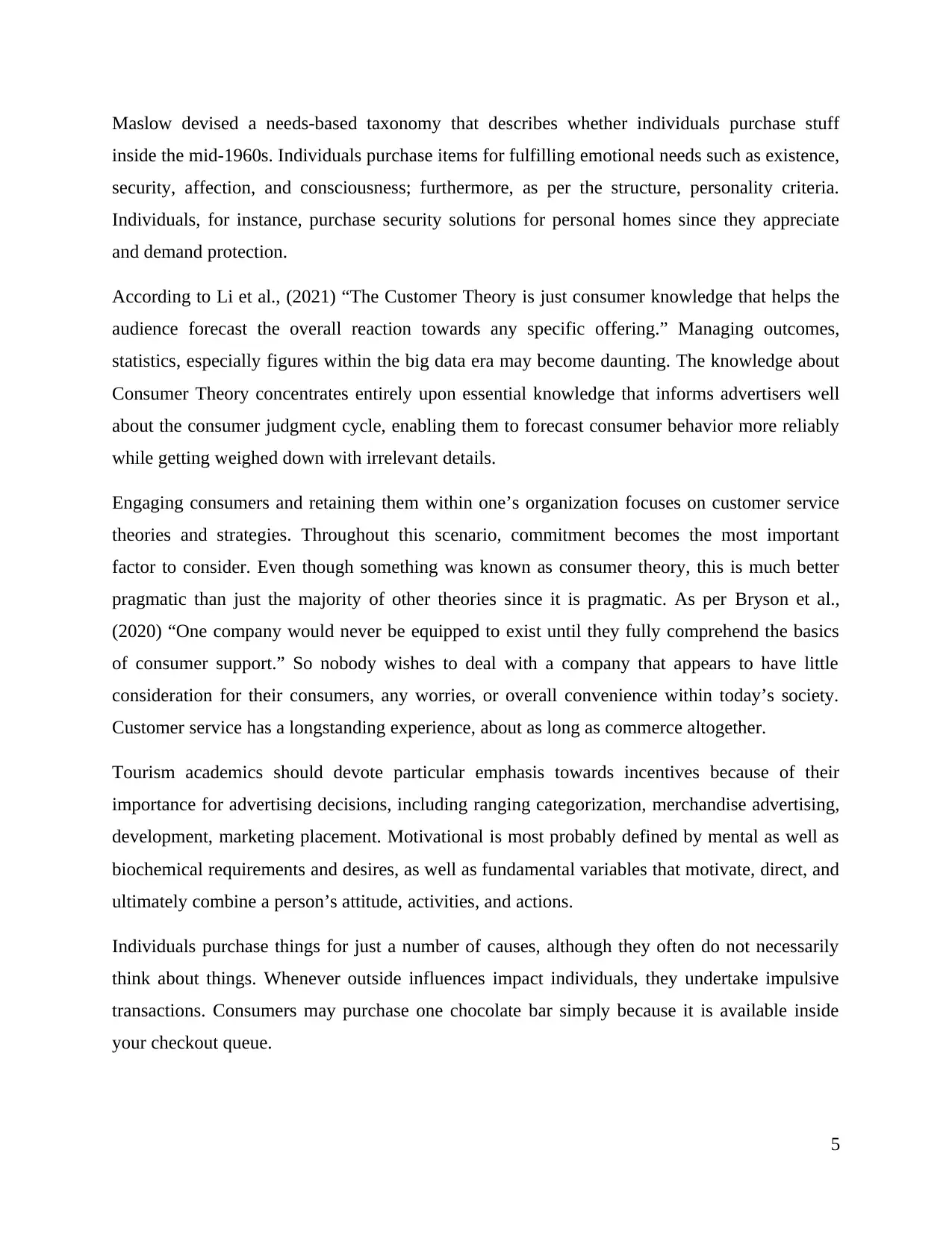
Maslow devised a needs-based taxonomy that describes whether individuals purchase stuff
inside the mid-1960s. Individuals purchase items for fulfilling emotional needs such as existence,
security, affection, and consciousness; furthermore, as per the structure, personality criteria.
Individuals, for instance, purchase security solutions for personal homes since they appreciate
and demand protection.
According to Li et al., (2021) “The Customer Theory is just consumer knowledge that helps the
audience forecast the overall reaction towards any specific offering.” Managing outcomes,
statistics, especially figures within the big data era may become daunting. The knowledge about
Consumer Theory concentrates entirely upon essential knowledge that informs advertisers well
about the consumer judgment cycle, enabling them to forecast consumer behavior more reliably
while getting weighed down with irrelevant details.
Engaging consumers and retaining them within one’s organization focuses on customer service
theories and strategies. Throughout this scenario, commitment becomes the most important
factor to consider. Even though something was known as consumer theory, this is much better
pragmatic than just the majority of other theories since it is pragmatic. As per Bryson et al.,
(2020) “One company would never be equipped to exist until they fully comprehend the basics
of consumer support.” So nobody wishes to deal with a company that appears to have little
consideration for their consumers, any worries, or overall convenience within today’s society.
Customer service has a longstanding experience, about as long as commerce altogether.
Tourism academics should devote particular emphasis towards incentives because of their
importance for advertising decisions, including ranging categorization, merchandise advertising,
development, marketing placement. Motivational is most probably defined by mental as well as
biochemical requirements and desires, as well as fundamental variables that motivate, direct, and
ultimately combine a person’s attitude, activities, and actions.
Individuals purchase things for just a number of causes, although they often do not necessarily
think about things. Whenever outside influences impact individuals, they undertake impulsive
transactions. Consumers may purchase one chocolate bar simply because it is available inside
your checkout queue.
5
inside the mid-1960s. Individuals purchase items for fulfilling emotional needs such as existence,
security, affection, and consciousness; furthermore, as per the structure, personality criteria.
Individuals, for instance, purchase security solutions for personal homes since they appreciate
and demand protection.
According to Li et al., (2021) “The Customer Theory is just consumer knowledge that helps the
audience forecast the overall reaction towards any specific offering.” Managing outcomes,
statistics, especially figures within the big data era may become daunting. The knowledge about
Consumer Theory concentrates entirely upon essential knowledge that informs advertisers well
about the consumer judgment cycle, enabling them to forecast consumer behavior more reliably
while getting weighed down with irrelevant details.
Engaging consumers and retaining them within one’s organization focuses on customer service
theories and strategies. Throughout this scenario, commitment becomes the most important
factor to consider. Even though something was known as consumer theory, this is much better
pragmatic than just the majority of other theories since it is pragmatic. As per Bryson et al.,
(2020) “One company would never be equipped to exist until they fully comprehend the basics
of consumer support.” So nobody wishes to deal with a company that appears to have little
consideration for their consumers, any worries, or overall convenience within today’s society.
Customer service has a longstanding experience, about as long as commerce altogether.
Tourism academics should devote particular emphasis towards incentives because of their
importance for advertising decisions, including ranging categorization, merchandise advertising,
development, marketing placement. Motivational is most probably defined by mental as well as
biochemical requirements and desires, as well as fundamental variables that motivate, direct, and
ultimately combine a person’s attitude, activities, and actions.
Individuals purchase things for just a number of causes, although they often do not necessarily
think about things. Whenever outside influences impact individuals, they undertake impulsive
transactions. Consumers may purchase one chocolate bar simply because it is available inside
your checkout queue.
5
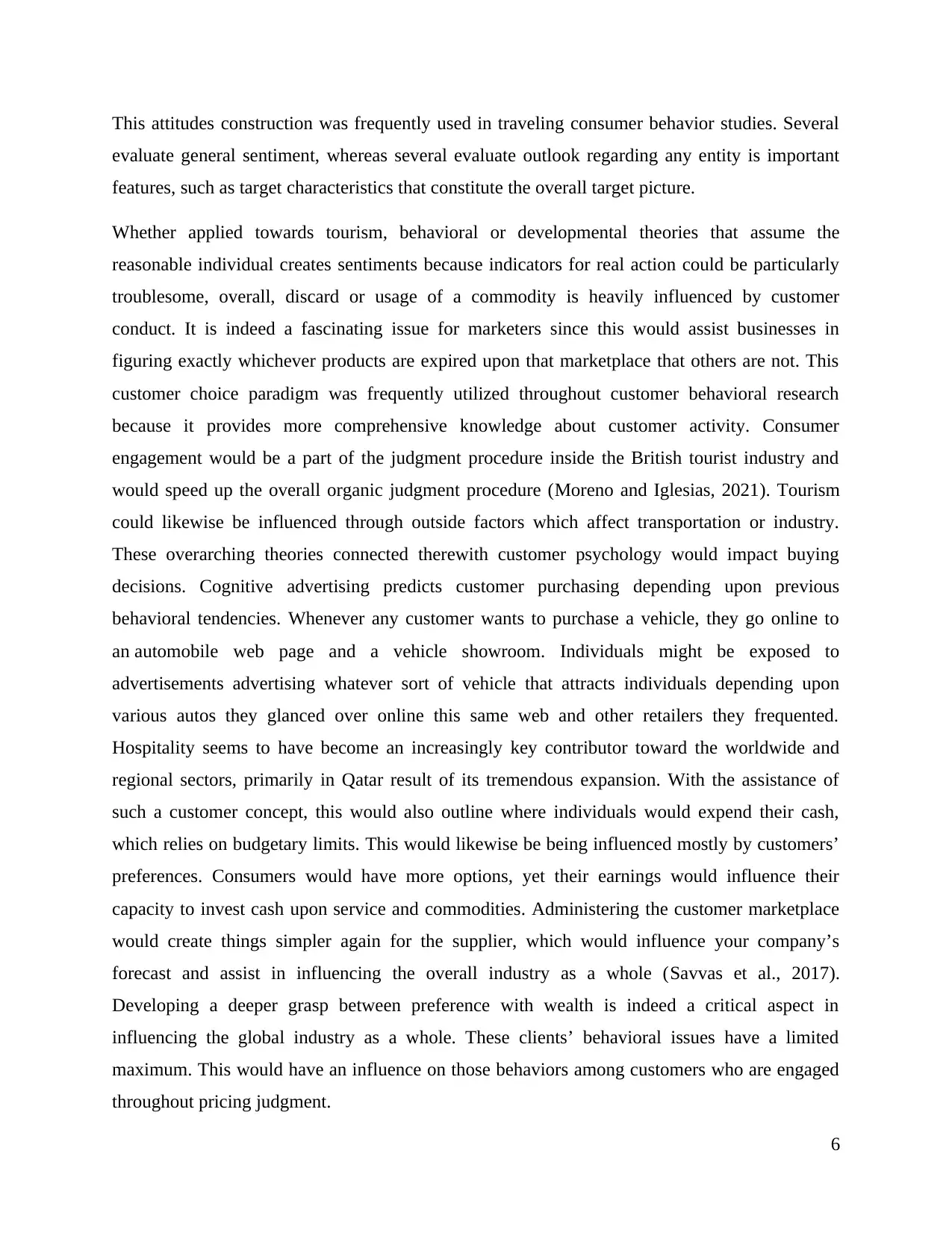
This attitudes construction was frequently used in traveling consumer behavior studies. Several
evaluate general sentiment, whereas several evaluate outlook regarding any entity is important
features, such as target characteristics that constitute the overall target picture.
Whether applied towards tourism, behavioral or developmental theories that assume the
reasonable individual creates sentiments because indicators for real action could be particularly
troublesome, overall, discard or usage of a commodity is heavily influenced by customer
conduct. It is indeed a fascinating issue for marketers since this would assist businesses in
figuring exactly whichever products are expired upon that marketplace that others are not. This
customer choice paradigm was frequently utilized throughout customer behavioral research
because it provides more comprehensive knowledge about customer activity. Consumer
engagement would be a part of the judgment procedure inside the British tourist industry and
would speed up the overall organic judgment procedure (Moreno and Iglesias, 2021). Tourism
could likewise be influenced through outside factors which affect transportation or industry.
These overarching theories connected therewith customer psychology would impact buying
decisions. Cognitive advertising predicts customer purchasing depending upon previous
behavioral tendencies. Whenever any customer wants to purchase a vehicle, they go online to
an automobile web page and a vehicle showroom. Individuals might be exposed to
advertisements advertising whatever sort of vehicle that attracts individuals depending upon
various autos they glanced over online this same web and other retailers they frequented.
Hospitality seems to have become an increasingly key contributor toward the worldwide and
regional sectors, primarily in Qatar result of its tremendous expansion. With the assistance of
such a customer concept, this would also outline where individuals would expend their cash,
which relies on budgetary limits. This would likewise be being influenced mostly by customers’
preferences. Consumers would have more options, yet their earnings would influence their
capacity to invest cash upon service and commodities. Administering the customer marketplace
would create things simpler again for the supplier, which would influence your company’s
forecast and assist in influencing the overall industry as a whole (Savvas et al., 2017).
Developing a deeper grasp between preference with wealth is indeed a critical aspect in
influencing the global industry as a whole. These clients’ behavioral issues have a limited
maximum. This would have an influence on those behaviors among customers who are engaged
throughout pricing judgment.
6
evaluate general sentiment, whereas several evaluate outlook regarding any entity is important
features, such as target characteristics that constitute the overall target picture.
Whether applied towards tourism, behavioral or developmental theories that assume the
reasonable individual creates sentiments because indicators for real action could be particularly
troublesome, overall, discard or usage of a commodity is heavily influenced by customer
conduct. It is indeed a fascinating issue for marketers since this would assist businesses in
figuring exactly whichever products are expired upon that marketplace that others are not. This
customer choice paradigm was frequently utilized throughout customer behavioral research
because it provides more comprehensive knowledge about customer activity. Consumer
engagement would be a part of the judgment procedure inside the British tourist industry and
would speed up the overall organic judgment procedure (Moreno and Iglesias, 2021). Tourism
could likewise be influenced through outside factors which affect transportation or industry.
These overarching theories connected therewith customer psychology would impact buying
decisions. Cognitive advertising predicts customer purchasing depending upon previous
behavioral tendencies. Whenever any customer wants to purchase a vehicle, they go online to
an automobile web page and a vehicle showroom. Individuals might be exposed to
advertisements advertising whatever sort of vehicle that attracts individuals depending upon
various autos they glanced over online this same web and other retailers they frequented.
Hospitality seems to have become an increasingly key contributor toward the worldwide and
regional sectors, primarily in Qatar result of its tremendous expansion. With the assistance of
such a customer concept, this would also outline where individuals would expend their cash,
which relies on budgetary limits. This would likewise be being influenced mostly by customers’
preferences. Consumers would have more options, yet their earnings would influence their
capacity to invest cash upon service and commodities. Administering the customer marketplace
would create things simpler again for the supplier, which would influence your company’s
forecast and assist in influencing the overall industry as a whole (Savvas et al., 2017).
Developing a deeper grasp between preference with wealth is indeed a critical aspect in
influencing the global industry as a whole. These clients’ behavioral issues have a limited
maximum. This would have an influence on those behaviors among customers who are engaged
throughout pricing judgment.
6
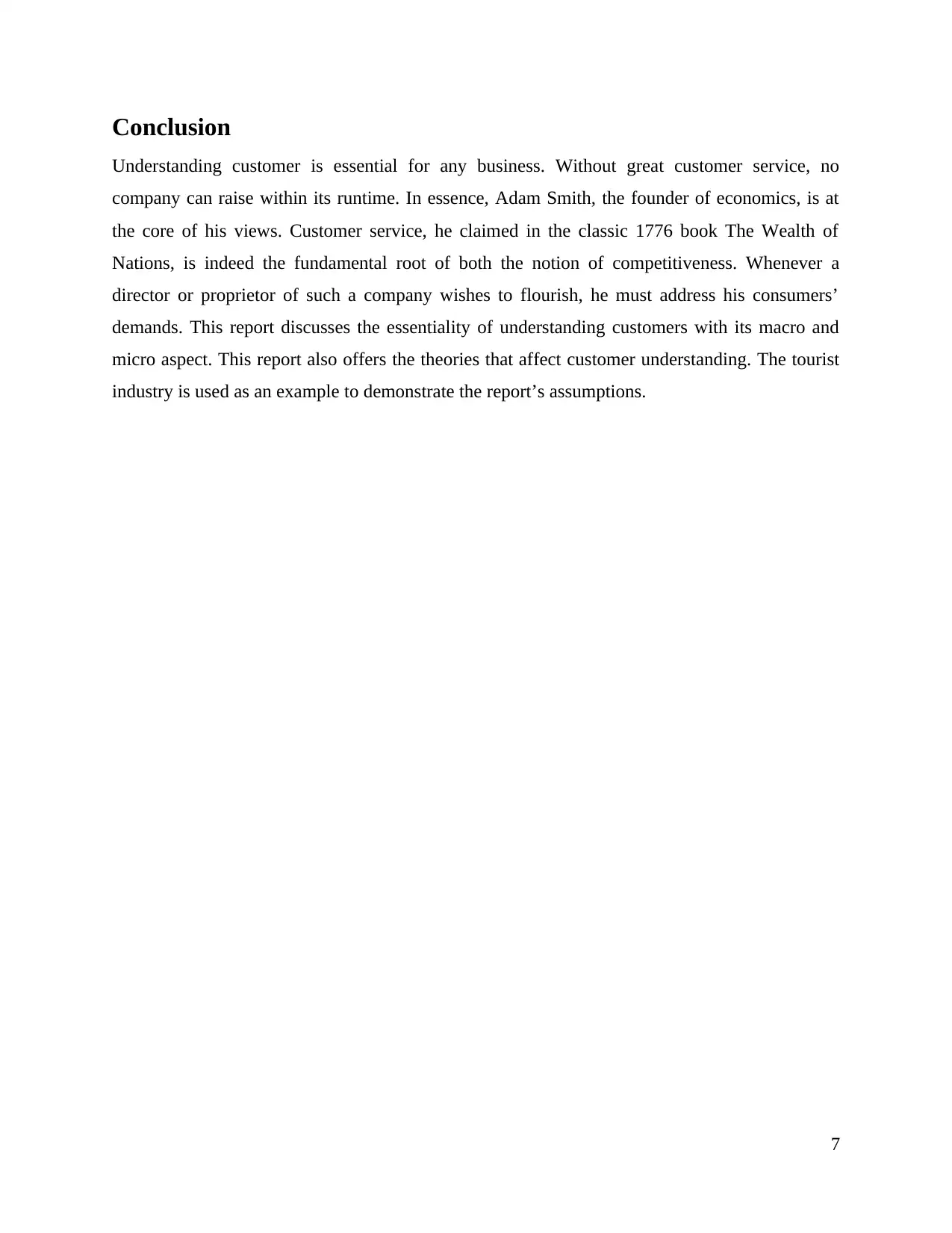
Conclusion
Understanding customer is essential for any business. Without great customer service, no
company can raise within its runtime. In essence, Adam Smith, the founder of economics, is at
the core of his views. Customer service, he claimed in the classic 1776 book The Wealth of
Nations, is indeed the fundamental root of both the notion of competitiveness. Whenever a
director or proprietor of such a company wishes to flourish, he must address his consumers’
demands. This report discusses the essentiality of understanding customers with its macro and
micro aspect. This report also offers the theories that affect customer understanding. The tourist
industry is used as an example to demonstrate the report’s assumptions.
7
Understanding customer is essential for any business. Without great customer service, no
company can raise within its runtime. In essence, Adam Smith, the founder of economics, is at
the core of his views. Customer service, he claimed in the classic 1776 book The Wealth of
Nations, is indeed the fundamental root of both the notion of competitiveness. Whenever a
director or proprietor of such a company wishes to flourish, he must address his consumers’
demands. This report discusses the essentiality of understanding customers with its macro and
micro aspect. This report also offers the theories that affect customer understanding. The tourist
industry is used as an example to demonstrate the report’s assumptions.
7
Paraphrase This Document
Need a fresh take? Get an instant paraphrase of this document with our AI Paraphraser
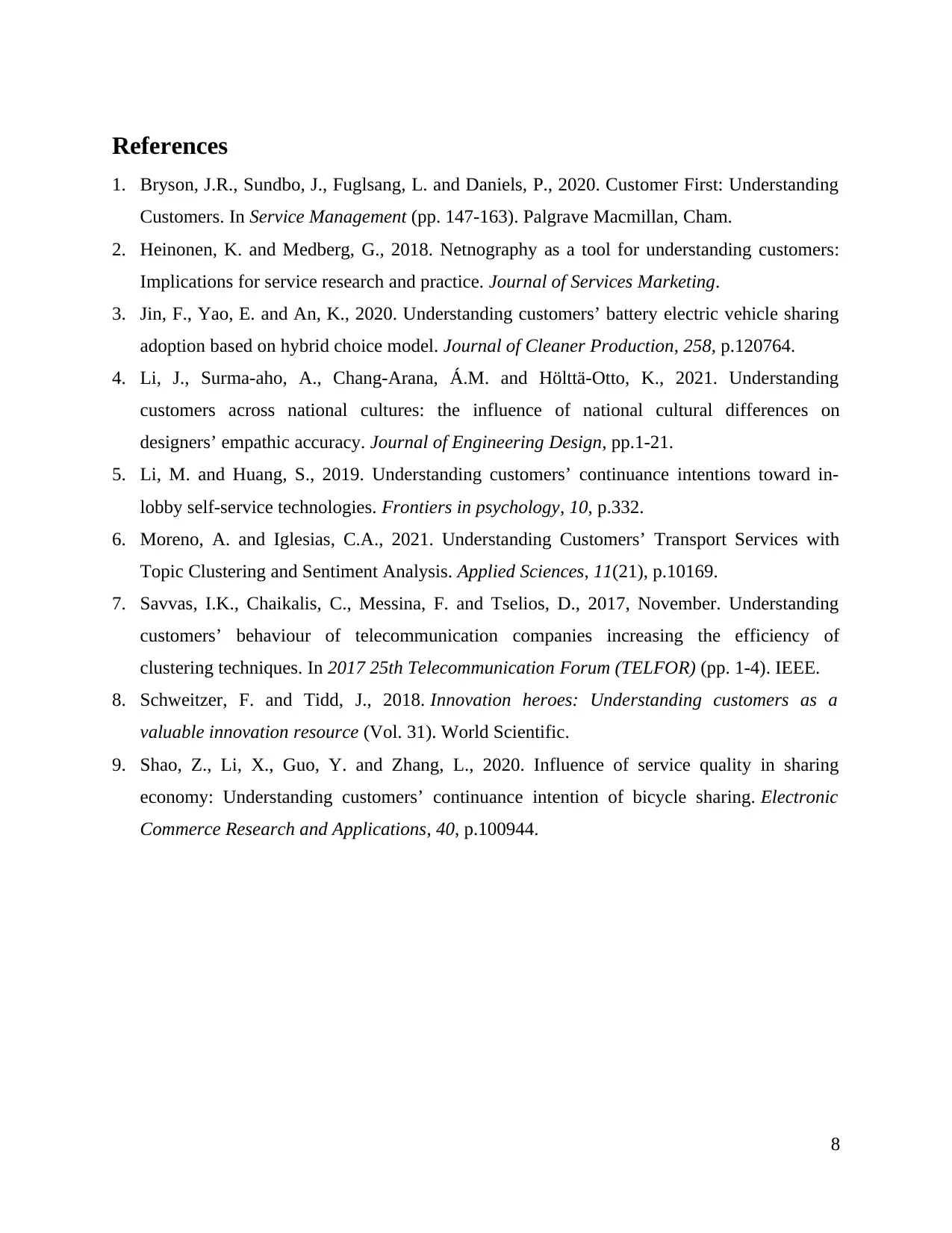
References
1. Bryson, J.R., Sundbo, J., Fuglsang, L. and Daniels, P., 2020. Customer First: Understanding
Customers. In Service Management (pp. 147-163). Palgrave Macmillan, Cham.
2. Heinonen, K. and Medberg, G., 2018. Netnography as a tool for understanding customers:
Implications for service research and practice. Journal of Services Marketing.
3. Jin, F., Yao, E. and An, K., 2020. Understanding customers’ battery electric vehicle sharing
adoption based on hybrid choice model. Journal of Cleaner Production, 258, p.120764.
4. Li, J., Surma-aho, A., Chang-Arana, Á.M. and Hölttä-Otto, K., 2021. Understanding
customers across national cultures: the influence of national cultural differences on
designers’ empathic accuracy. Journal of Engineering Design, pp.1-21.
5. Li, M. and Huang, S., 2019. Understanding customers’ continuance intentions toward in-
lobby self-service technologies. Frontiers in psychology, 10, p.332.
6. Moreno, A. and Iglesias, C.A., 2021. Understanding Customers’ Transport Services with
Topic Clustering and Sentiment Analysis. Applied Sciences, 11(21), p.10169.
7. Savvas, I.K., Chaikalis, C., Messina, F. and Tselios, D., 2017, November. Understanding
customers’ behaviour of telecommunication companies increasing the efficiency of
clustering techniques. In 2017 25th Telecommunication Forum (TELFOR) (pp. 1-4). IEEE.
8. Schweitzer, F. and Tidd, J., 2018. Innovation heroes: Understanding customers as a
valuable innovation resource (Vol. 31). World Scientific.
9. Shao, Z., Li, X., Guo, Y. and Zhang, L., 2020. Influence of service quality in sharing
economy: Understanding customers’ continuance intention of bicycle sharing. Electronic
Commerce Research and Applications, 40, p.100944.
8
1. Bryson, J.R., Sundbo, J., Fuglsang, L. and Daniels, P., 2020. Customer First: Understanding
Customers. In Service Management (pp. 147-163). Palgrave Macmillan, Cham.
2. Heinonen, K. and Medberg, G., 2018. Netnography as a tool for understanding customers:
Implications for service research and practice. Journal of Services Marketing.
3. Jin, F., Yao, E. and An, K., 2020. Understanding customers’ battery electric vehicle sharing
adoption based on hybrid choice model. Journal of Cleaner Production, 258, p.120764.
4. Li, J., Surma-aho, A., Chang-Arana, Á.M. and Hölttä-Otto, K., 2021. Understanding
customers across national cultures: the influence of national cultural differences on
designers’ empathic accuracy. Journal of Engineering Design, pp.1-21.
5. Li, M. and Huang, S., 2019. Understanding customers’ continuance intentions toward in-
lobby self-service technologies. Frontiers in psychology, 10, p.332.
6. Moreno, A. and Iglesias, C.A., 2021. Understanding Customers’ Transport Services with
Topic Clustering and Sentiment Analysis. Applied Sciences, 11(21), p.10169.
7. Savvas, I.K., Chaikalis, C., Messina, F. and Tselios, D., 2017, November. Understanding
customers’ behaviour of telecommunication companies increasing the efficiency of
clustering techniques. In 2017 25th Telecommunication Forum (TELFOR) (pp. 1-4). IEEE.
8. Schweitzer, F. and Tidd, J., 2018. Innovation heroes: Understanding customers as a
valuable innovation resource (Vol. 31). World Scientific.
9. Shao, Z., Li, X., Guo, Y. and Zhang, L., 2020. Influence of service quality in sharing
economy: Understanding customers’ continuance intention of bicycle sharing. Electronic
Commerce Research and Applications, 40, p.100944.
8
1 out of 8
Related Documents
Your All-in-One AI-Powered Toolkit for Academic Success.
+13062052269
info@desklib.com
Available 24*7 on WhatsApp / Email
![[object Object]](/_next/static/media/star-bottom.7253800d.svg)
Unlock your academic potential
© 2024 | Zucol Services PVT LTD | All rights reserved.


